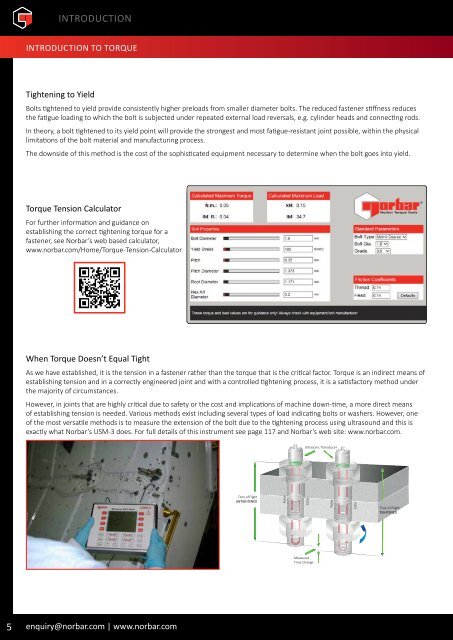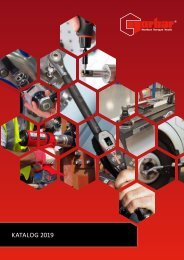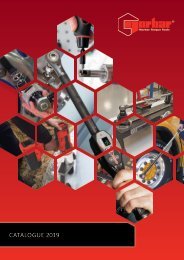Norbar Catalogue 2019
Torque Tool and equipment catalogue from Norbar Torque Tools
Torque Tool and equipment catalogue from Norbar Torque Tools
Create successful ePaper yourself
Turn your PDF publications into a flip-book with our unique Google optimized e-Paper software.
INTRODUCTION<br />
INTRODUCTION TO TORQUE<br />
Tightening to Yield<br />
Bolts tightened to yield provide consistently higher preloads from smaller diameter bolts. The reduced fastener stiffness reduces<br />
the fatigue loading to which the bolt is subjected under repeated external load reversals, e.g. cylinder heads and connecting rods.<br />
In theory, a bolt tightened to its yield point will provide the strongest and most fatigue-resistant joint possible, within the physical<br />
limitations of the bolt material and manufacturing process.<br />
The downside of this method is the cost of the sophisticated equipment necessary to determine when the bolt goes into yield.<br />
Torque Tension Calculator<br />
For further information and guidance on<br />
establishing the correct tightening torque for a<br />
fastener, see <strong>Norbar</strong>’s web based calculator,<br />
www.norbar.com/Home/Torque-Tension-Calculator<br />
When Torque Doesn’t Equal Tight<br />
As we have established, it is the tension in a fastener rather than the torque that is the critical factor. Torque is an indirect means of<br />
establishing tension and in a correctly engineered joint and with a controlled tightening process, it is a satisfactory method under<br />
the majority of circumstances.<br />
However, in joints that are highly critical due to safety or the cost and implications of machine down-time, a more direct means<br />
of establishing tension is needed. Various methods exist including several types of load indicating bolts or washers. However, one<br />
of the most versatile methods is to measure the extension of the bolt due to the tightening process using ultrasound and this is<br />
exactly what <strong>Norbar</strong>’s USM-3 does. For full details of this instrument see page 117 and <strong>Norbar</strong>’s web site: www.norbar.com.<br />
Ultrasonic Transducer<br />
Time of Flight<br />
UNTIGHTENED<br />
Pulse<br />
Echo<br />
Pulse<br />
Echo<br />
Time of Flight<br />
TIGHTENED<br />
Measured<br />
Time Change<br />
5 enquiry@norbar.com | www.norbar.com







